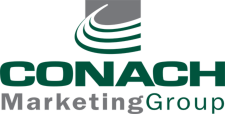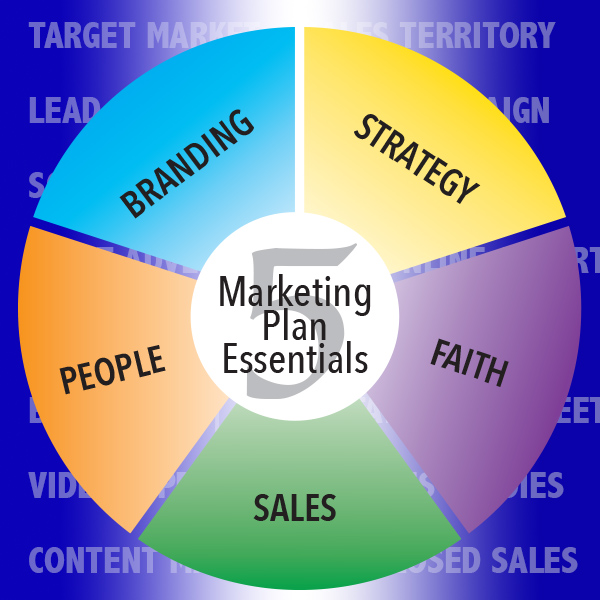Financial marketing program
The five essentials of a financial marketing program
Developing a financial marketing program as you go along usually doesn’t yield the best results. Your sales and marketing program is an investment in the future of your firm. For this reason, you need to consider what you will need to make it a successful venture. This blog discusses the essential areas you need to have in place for a proactive and integrated financial advisor marketing program:
• Brand
• Strategy
• People
• Budget
• Faith
First – have a brand for your financial marketing program
Often, a company’s brand is only thought of as its logo. In fact, it is much deeper than that. Your firm’s brand needs to incorporate three elements: your logo, your messaging, and your image. Let’s look at these elements:
A logo needs to inform and connect with potential clients. By using proven design techniques of color, shape, balance, and font, it can express your values and attract prospects subliminally. For the most part, many financial firms use a logotype. This logo design does not have an icon; it works only with font and color. While this approach works, it must also be designed well to reflect your company. Another critical point is to be sure your logo is not outdated. Because design can follow trends, logos created several years, or decades ago can present your firm as out-of-date.
Messaging is the messages you use in your financial marketing program. These messages express your core values, the services you offer, and the benefits you deliver. Consequently, your messaging sets you apart from the competition and give prospects reason to hire your firm.
An image is the design of your sales and lead generation material. It is the sum of the page layout, images, fonts and colors you are using. Like your logo, it affects a potential customer either positively or negatively on a subconscious level. For this reason, you need a professional designer to create your logo and image to assure the proper techniques are employed.
Your brand must have cohesion. If your brand is not consistent in your financial marketing program, it will send mixed messages. This issue can confuse potential clients, causing them to look unfavorably on your firm. Implementing a brand management process will keep your brand uniform throughout the various aspects of your program.
Second – Have a plan for your financial marketing program
This point may sound like an obvious statement, but it’s not. In the beginning, many of my financial clients believed a brand, brochure, and website equals a financial marketing program. While these elements are part of the program, they are not the whole. You need to develop three areas to have a proactive, functioning plan: marketing, lead generation, and sales.
Marketing involves your brand (already discussed) and the strategy to acquire new clients. It is the plan you have in place to make the market aware of your firm and which potential clients you want to target. Because this plan is ever-evolving, you need to review at least yearly.
Lead generation is the campaign to attract new clients. This effort will involve lead generation channels. It is essential to understand the effect of the different channels on the campaign. First, awareness channels, such as radio or billboards present your firm to a large, unqualified audience. Second, target channels, like trade social media and website optimization, focus on groups of prospects that should be interested in your services. Direct channels connect with potential clients on a one-on-one basis through prospecting calls or direct mail. Your campaign doesn’t have to be a multi-faceted campaign involving several channels. It can start small and grow. Because Conach specializes in small business marketing, we know that budgets can be tight. Even if your plan starts small, with only prospecting calls and e-bulletin campaign, be sure you keep it on track by following a set schedule.
Sales is the process of getting a new client – not just getting the contract signed. That part is just the final step. A sale begins with the material used to respond to a lead, continuing through to the close of the sale. Because sales is a process, you will need multiple sales tools to use throughout the process. These tools could be response brochures, target market material, case studies, service sheets or customer testimonials.
Third – Have the people to implement your financial marketing program
Developing a marketing plan without the people to achieve it is like building a car without an engine. If you want to have in-house staff to handle the implementation, you will need people that can develop a campaign, write copy, design material, work with vendors, manage and evaluate the campaign, and act as salespeople. Hiring that level of expertise can be expensive. Outsourcing these tasks to a qualified agency (such as Conach) provides an affordable team with the experience and skills to produce and manage a campaign.
Fourth – Have a budget for your financial marketing program
You would think that a financial firm would have no trouble developing a budget. While it is true that most financial clients have a budget, it is usually a lump sum that catches everything regarding sales and marketing. To better understand where to spend your money, divide the budget into different areas. These main areas should be lead generation and sales. These two categories can then be broken down further to capture the different items in each. For example, lead generation could have sections for awareness advertising, direct lead generation, and networking. Sales would cover the various material needed, like brochures, giveaways, and branded clothing. Without a detailed budget, you can’t make decisions on the number of lead generation tactics you can employ, how many target markets you can approach, or the types of sales material you can develop.
Clients always ask how much to spend on sales and marketing. A good rule of thumb for a financial marketing program budget is .25% – 3% of your annual sales. The percentage you choose will be in direct proportion to how much you want your firm to grow and the competitiveness of your sales territory.
Fifth – Have faith in your financial marketing program
Remember that a plan takes time to develop, implement and adjust. You might not see instant results. However, if you have put in the time and effort to establish a solid one, you will. You need to keep the faith. It is a rare occasion for a well-executed marketing plan to fail to bring in new sales, just as it is rare for a sound investment to fail to yield returns.
Pappy
Paul Kowalski (or Pappy as he is called around the office) spent over two decades working at other agencies before opening Conach Marketing Group in 2008. The early part of his career was working with Fortune 500 clients at different agencies. However, working with smaller clients was his preference. This choice was because of the impact on a client’s business growth and the forming closer, personal relationships.
When he was creating Conach, his goal was to bring those Fortune 500 strategies along with years of B2B marketing experience to small business marketing clients. As a result of focusing on business to business marketing, Conach specializes in construction marketing, financial marketing, and industrial marketing. Even though we are in Mid-Michigan, Conach provides marketing services to clients across the country.
For more information visit conachmarketing.com or contact us or call 989.401.3202.

